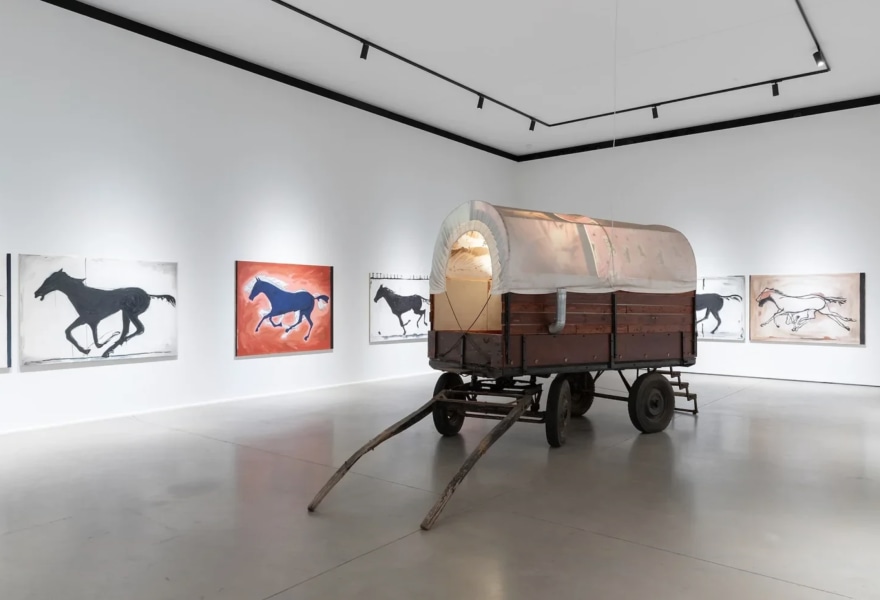09 december 2024, Emily Van Driessen
Aaron-Victor Peeters: An Exhibition as a Time Machine
A covered wagon that doesn’t move. Horses galloping backwards. Cars without engines, yet filled with a romantic soul. Aaron-Victor Peeters (1994, Genk) is a Belgian artist exploring themes of time, movement, and the reinterpretation of objects.
His exhibition Rum Runner at Uitstalling Gallery, showcasing works from 2019 to the present, is an ode to being on the move. “But when are you truly on your way?” Aaron asks. “Is it when you’re physically moving, or when your mind is traveling?”
The Covered Wagon
At the center of the exhibition is the covered wagon On The Road, 2024, a piece that spent five years in Aaron’s studio. What started as a graduation project has become the anchor for an exhibition that challenges our perception of time and movement. “It’s like a pillow fort,” Aaron explains. “Inside, you’ll find a child’s world, cowboy figures, blankets, and looping scenes from Western films.”
But even those Westerns, so iconic of the “real America,” are an illusion. Many were shot in Spain or Italy, based on books by Karl May, a German author who never visited America. It’s a perfect example of Aaron’s fascination with myth-making: how the past is romanticized and reimagined. “What is even real anymore?” he wonders.
The wagon’s power lies in the tension it creates. The child dreams of movement, imagining a journey, while the wagon itself appears ready to depart. It’s an object caught between potential and reality: a metaphor for how we can travel through our imagination even while standing still.

Aaron-Victor Peeters, On The Road, 2024, Uitstalling Gallery
Horses in Reverse
Surrounding the wagon are paintings of galloping horses, inspired by Muybridge’s groundbreaking motion studies. Muybridge was the first to capture movement in a sequence of images, a milestone in the history of film and photography. For Aaron, these paintings build on the themes of the wagon, reflecting on what it means to be in motion.
“In Muybridge’s work, the horses move to the right, toward the future,” Aaron explains. “In my paintings, they move to the left, back into the past.” This subtle reversal adds a layer of nostalgia and critique, presenting a world where time isn’t linear but circular.
Together with the wagon, the paintings form what Aaron’s gallerist, Danny Weckx, calls an “institutional experience.” “It’s not about individual works, it’s about the full story.”

Aaron-Victor Peeters, Sally (#5) & Sally #11), 2024, Uitstalling Gallery
The Car as Fossil
The car is another recurring motif in Aaron’s work. He explores how iconic objects, like cars, will be perceived in the future. Today, cars symbolize freedom and status, but what will they mean 200 years from now?
Aaron compares this to how we view ancient objects, like Venus statues or columns. Our understanding of these relics is based on fragments of knowledge, much of which has been lost over time. What remains is often a romantic reconstruction of meanings we can’t fully grasp. How will people in the future interpret cars using only the fragments of our era that survive?

Aaron-Victor Peeters, Untitled, 2024, Uitstalling Gallery
Aaron searches secondhand websites for cars that no longer run, some without engines. These vehicles sit in his studio for years, serving as objects to dream about. “I’m fascinated by science fiction from the 1970s,” he says, “stories that imagined the ‘now.’ But when we look back, those predictions were completely off.”
In Aaron’s work, the car, once a romantic icon of freedom, becomes a fossil. A silent witness to stories that keep evolving. Using maquettes and sketches, he imagines how cars could be repurposed. These models are like mental roadmaps, spaces where he can explore future possibilities.
At Art Antwerp 2024, Aaron presents an installation featuring a car that embodies these ideas. The piece shows how objects carry stories and that they keep being rewritten, even when the objects themselves no longer function.

Aaron-Victor Peeters, Drive-in cinema (Maquette)., 2024, Uitstalling Gallery
In Conclusion
The car won’t start, and the wagon won’t roll, yet Aaron-Victor Peeters shows that imagination never stops moving.
Rum Runner is on view until January 12, 2025, at Uitstalling Gallery.
